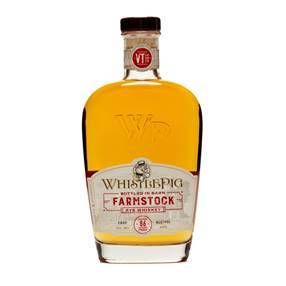In the world of rye whiskey, there’s Before WhistlePig and After WhistlePig. After decades as a forgotten American whiskey, rye was already making a comeback in 2010, when WhistlePig launched. But this is the brand that put it back on the map in a big way. Distilled from 100% rye when virtually every other brand was a corn/rye hybrid, aged for a full 10 years, and bottled at a hefty 100 proof, WhistlePig set the course for big, flavorful ryes that packed a wallop when it came to both flavor and alcohol content.
WhistlePig pretty much came out of nowhere — founder Raj Peter Bhakta, who’d never been involved in the spirits business, bought a picturesque farm in Vermont in 2007, and then somehow acquired the services of distiller Dave Pickerell, best known for his work with Maker’s Mark, to help create the whiskey. What most folks either didn’t know or didn’t want to know — this being the time before transparency — was that WhistlePig was bottled at the farm, but it had been grown, distilled and aged in Canada. Which didn’t make it any less delicious, but the idea of WhistlePig was more romantic than the reality.
Bhakta’s vision from the get-go has been to turn the Vermont farm into a functioning distillery to produce “triple terroir” whiskey. Say what? “The triple terroir is our grain, our water, our wood,” Bhakra told me. “That means it has been distilled from grain that we harvested, aged in barrels of estate oak — Vermont oak — and it was made using our water.” It took a decade, but with WhistlePig’s new, limited edition FarmStock bottling, launched this week, he’s finally achieved his goal, at least in part.
The initial rye harvest, in 2015, was fairly small, and the whiskey from which it was made is still quite young — about 18 months. That’s why the triple terroir portion of FarmStock is only 20% of the final blend. The remainder is about 50% 6 year old “double terroir” rye (harvested and distilled in Canada, aged in Vermont oak, brought down to bottling proof with local water) and 30% 12 year old Indiana rye.

Triple terroir whiskey — it’s a thing now!
FarmStock is not the WhistlePig we’ve come to know and love, which is a good thing. I mean, why put in all that effort to make a product that’s just like what you already have? It reminds me of a classic Maryland rye — softer than most ryes of the WhistlePig era, sweeter and fruitier on the palate, with a gentler spice that takes longer to make its presence felt. Unlike standard WhistlePig, whose powerful flavor makes it a perfect base for cocktails, FarmStock is more of a sipper. Given its $90 price tag, it’s on the pricey side for a mixer anyway.
For a slightly geeky dive into the how-comes, I asked Bhakta what makes it so different. It’s the grain, he said: “The result that we’re getting is a lot creamier, it tastes lighter, yet it also has a lot more going on in terms of tasting the vibrancy of a new grain. Normally there’s a very high element of harshness in rye. The rye we distill here is much less harsh. So the result of that is that it actually can be put into a whiskey earlier than the original distillate that we received down from Canada.”
It’s also the wood. “The oak [in Vermont] is at the northern limit of its growing range, and the result of that is it grows more slowly. So the wood itself is denser and more flavorful. And that’s really important because most of the flavor you get in your whiskey comes from the wood.”
And it’s the blend. “You’ve got 12 year in it – its base is 6 year, a good amount of 12 year – and so in one package, if it were a human being, it would have, like, all the wisdom of an 80 year old, the hustle and enthusiasm of a 20 year old, and, um, you know.” “The liveliness of a kid?” I suggest. “Yeah, right.”
It’s even the proof, which is down to 86 (43% alcohol by volume). “With our triple terroir whiskey, it is young, and in the opinion of Dave [Pickerell] and pretty much everybody who tasted it, [the lower proof] has the right balance between picking up the vibrancy and promise of the young whiskey without overpowering it. And it tasted better!” Which is good enough for me. (Bhakta helpfully points out that you’ll still feel the effects if you down a few FarmStocks.)
The bad news is that the first batch of FarmStock is available in pretty limited quantities; exact numbers aren’t available, but only about 100 barrels were laid down. The good news is that they’ll be making more every year, although the flavor profile will evolve as the triple terroir whiskey ages and takes a greater role in the blend. The even better news is that classic WhistlePig (and its spinoffs, Old World, Boss Hog, and 15 Year Old Vermont Estate Oak Finished) will still be around indefinitely. So you’ll have plenty of opportunities to compare and contrast. Trust me, there are worse ways to spend an evening.
